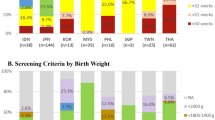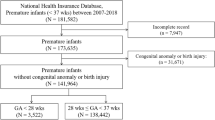Abstract
Objective
To increase preoperative identification of at-risk infants for severe Retinopathy of prematurity (ROP) to >95% by August 2016, with a secondary aim of reducing the number of infants with 100% intraoperative peripheral oxygen saturation (SpO2) during the same time.
Study design
Prospective quality improvement project centered on preterm surgical infants admitted to Primary Children’s Hospital (n = 41). Preoperative ROP risk identification rates were analyzed using an annotated run chart, intraoperative SpO2 and laser intervention were compared using un-paired t test.
Results
Preoperative identification of ROP risk increased from 60 to 100% and no infant was exposed to 100% SpO2 intraoperatively during the study period. The incidence of laser intervention in this population decreased by 45% from 22 to 12% (p = 0.21).
Conclusion
Simplifying our preoperative handoff increased our rates of correct identification and communication ROP risk in preterm infants while decreasing exposure to 100% SpO2.
This is a preview of subscription content, access via your institution
Access options
Subscribe to this journal
Receive 12 print issues and online access
$259.00 per year
only $21.58 per issue
Buy this article
- Purchase on Springer Link
- Instant access to full article PDF
Prices may be subject to local taxes which are calculated during checkout




Similar content being viewed by others
References
Kong L, Fry M, Al-Samarraie M, Gilbert C, Steinkuller PG. An update on progress and the changing epidemiology of causes of childhood blindness worldwide. J AAPOS. 2012;16:501–7.
Bonotto LB, Moreira AT, Chuffi S, Sckudlarek SM. Comparative study of visual functions in premature pre-school children with and without retinopathy of prematurity. Arq Bras Oftalmol. 2014;77:34–9.
Fielder A, Blencowe H, O’Connor A, Gilbert C. Impact of retinopathy of prematurity on ocular structures and visual functions. Arch Dis Child Fetal Neonatal Ed. 2015;100:F179–84.
Kaufman DA, Zanelli SA, Gurka MJ, Davis M, Richards CP, Walsh BK. Time outside targeted oxygen saturation range and retinopathy of prematurity. Early Hum Dev. 2014;90(Suppl 2):S35–40.
Schmidt B, Whyte RK, Asztalos EV, Moddemann D, Poets C, Rabi Y, et al. Effects of targeting higher vs lower arterial oxygen saturations on death or disability in extremely preterm infants: a randomized clinical trial. JAMA. 2013;309:2111–20.
SSGotEKSNNR Network, Carlo WA, Finer NN, Walsh MC, Rich W, Gantz MG, et al. Target ranges of oxygen saturation in extremely preterm infants. N Engl J Med. 2010;362:1959–69.
Tlucek PS, Corff KE, Bright BC, Bedwell SM, Sekar KC, Siatkowski RM. Effect of decreasing target oxygen saturation on retinopathy of prematurity. J AAPOS. 2010;14:406–11.
Kopp VJ. Hyperoxia in pediatric anesthesia: time for reconsideration? Anesthesiology. 2009;111:1383.
Sola A. Oxygen in neonatal anesthesia: friend or foe? Curr Opin Anaesthesiol. 2008;21:332–9.
Sola A, Rogido MR, Deulofeut R. Oxygen as a neonatal health hazard: call for detente in clinical practice. Acta Paediatr. 2007;96:801–12.
Durell J, Hall NJ, Drewett M, Paramanantham K, Burge D. Emergency laparotomy in infants born at <26 weeks gestation: a neonatal network-based cohort study of frequency, surgical pathology and outcomes. Arch Dis Child Fetal Neonatal Ed. 2017;102:F504–F507.
Friddle KM, Yoder BA, Hartnett ME, Henry E, DiGeronimo RJ. Can a risk factor based approach safely reduce screening for retinopathy of prematurity?. Int J Pediatr. 2017;2017:8
Torr C, Yoder B, Beachy J. Assessing the surgical experience to identify risk factors associated with severe retinopathy of prematurity and laser intervention. Neonatology. 2018;114:230–4.
Sears JE, Pietz J, Sonnie C, Dolcini D, Hoppe G. A change in oxygen supplementation can decrease the incidence of retinopathy of prematurity. Ophthalmology. 2009;116:513–8.
Author information
Authors and Affiliations
Corresponding author
Ethics declarations
Conflict of interest
The authors declare that they have no conflict of interest.
Additional information
Publisher’s note: Springer Nature remains neutral with regard to jurisdictional claims in published maps and institutional affiliations.
Rights and permissions
About this article
Cite this article
Torr, C., Yoder, B. & Beachy, J. Improving preoperative identification of infants at risk for severe retinopathy of prematurity. J Perinatol 39, 1309–1314 (2019). https://doi.org/10.1038/s41372-019-0383-0
Received:
Revised:
Accepted:
Published:
Issue Date:
DOI: https://doi.org/10.1038/s41372-019-0383-0



